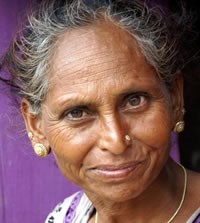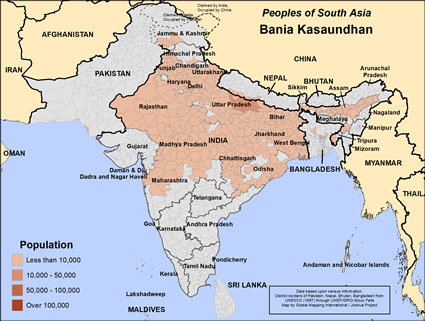Bania Kasaundhan in Nepal

Photo Source:
Copyrighted © 2026
Isudas All rights reserved. Used with permission |

Map Source:
People Group data: Omid. Map geography: UNESCO / GMI. Map Design: Joshua Project.
|
| People Name: | Bania Kasaundhan |
| Country: | Nepal |
| 10/40 Window: | Yes |
| Population: | 2,200 |
| World Population: | 509,200 |
| Primary Language: | Bhojpuri |
| Primary Religion: | Hinduism |
| Christian Adherents: | 0.00 % |
| Evangelicals: | 0.00 % |
| Scripture: | Complete Bible |
| Ministry Resources: | Yes |
| Jesus Film: | Yes |
| Audio Recordings: | Yes |
| People Cluster: | South Asia Forward Caste - Bania |
| Affinity Bloc: | South Asian Peoples |
| Progress Level: |
|
Introduction / History
The Banias originated over 5,000 years ago in Gujarat and Rajasthan, and they are also called Vania or Mahajan. Their name is derived from Vaniji, which means "trader" in Sanskrit, an ancient South Asian language.
Of the four major varnas (caste clusters), Banias are in the third one, the Vaishyas. This caste cluster has always been about trade, business and money lending. Throughout history they were traders of grain and spices. Despite their high incomes, the Banias have only modest status in the Hindu caste pyramid. They resent the higher two varnas, the Brahmins and the Kshatriyas, and thus Banias have often been leaders in caste reform movements. Mahatma Gandhi is one example, but there have been many others throughout India's long history.
There are smaller groups of Banias, one of which is the Kasaundhan. They live all over India. A few are in Nepal.
What Are Their Lives Like?
Members of the Bania caste are among the wealthiest people in India and even the world. Today they are still involved with businesses and money lending. A Kasaundhan Bania might be the proud owner of a giant business, a small one, or he might be working in a bank. He often owns the bank. Others work in government ministries or as lawyers, judges, teachers, scholars, stockbrokers or engineers.
Kasaundhan Bania fathers teach their children business skills. From an early age, children are drilled in math and detailed calculations with the end purpose of winning in money transactions. Bania parents often teach their children to "never give; always bargain and make money." This attitude can make them unpopular with other communities. Other castes often resent them because they lend much needed money at high interest rates. A pre-literate farmer might take a loan from a Bania only to find that a high percentage of his harvest will be taken away as interest. Customers often must put their farms or their gold up for collateral in case they cannot pay back their loans.
Floor painting and folk songs are a major part of the Bania's art and culture.
What Are Their Beliefs?
Nearly all Kasaundhan Banias claim the Hindu religion, but as merchants they have chosen gods that reflect their profession. They worship the god of wealth, the god of good fortune and the god of money. The rupee (Indian currency) is sacred with the Bania, and they use old coins for religious ceremonies. Ganesh (the god who helps overcome obstacles) and Lakshmi (the goddess of wealth) are among their favorites. Many are devoted to Vishnu and Shrinathji. Some are Jains, a reform movement of Hinduism.
What Are Their Needs?
Kasaundhan Banias need the spiritual hunger it takes to look beyond money. Currently, they are satisfied with their situation. Few if any are looking to the cross.
Prayer Points
Pray that the veil will be lifted from their spiritual eyes and the revelation of Jesus Christ will fall on them.
Pray that the principalities and powers would be bound that stifle the gospel, and that God will call workers to this unharvested field.
Pray that salvation will sweep through Kasaundhan communities, bringing them joy and hope.